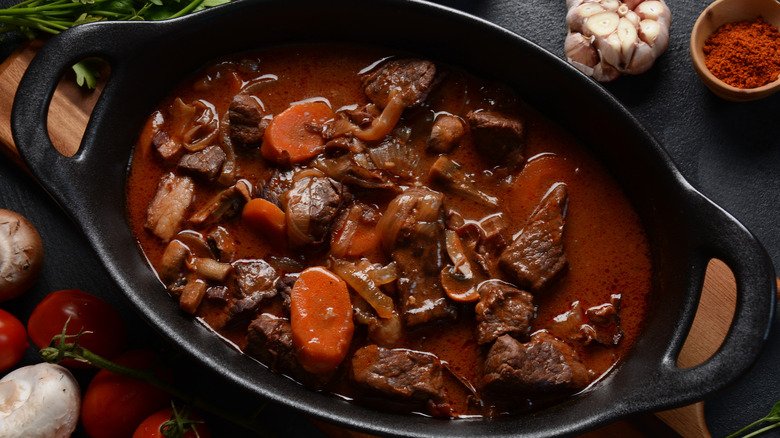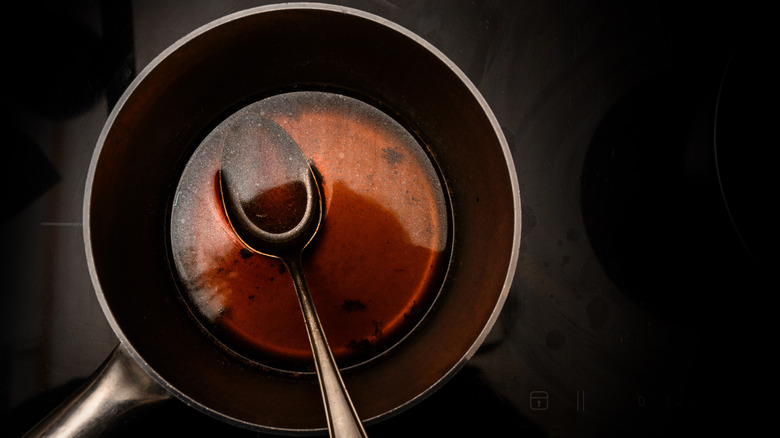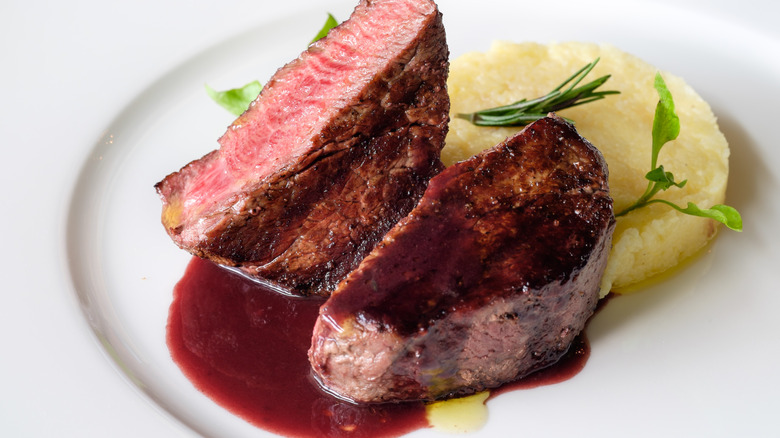For Maximum Flavor, Reduce Red Wine Before Cooking With It
An easy way to add a complex flavor to nearly any dish is to add a bit of wine into the mix. What's Cooking America says that wine can be used at multiple stages of the cooking process. You can use it as an acidic component in a marinade, add it to the cooking liquid of braised dishes like coq au vin or beef bourguignon, incorporate it into the preparation of a sauce, or mix it into a fruity dessert.
Decanter notes that something to look out for is to always use a wine that you would be happy to drink. Some folks use the label of "cooking wine" as a diminutive phrase to dismiss it as being poor quality — and while you don't need the most expensive wine — you still want something that will add an enjoyable flavor to your food, and it should never be a bottle that has spoiled or been corked.
One easy way to enhance the flavor that wine adds to your dish is to make it into a reduction.
You can do it, just reduce it
A key to developing many classic sauces, according to More Than Gourmet, is to create a reduction. Making a reduction is a simple process. All that it takes is a little bit of time on the stove to cook off some of the liquid in whatever you're reducing. Not only will this create a thicker sauce, but it will also help to concentrate the flavor of whatever you are reducing. An easy way to create a no-fuss sauce is to add some stock or wine to a pan that contains meat drippings, let it reduce, enrich it with a fat like butter or oil, and add herbs for flavor. This will capture the flavor from the drippings, concentrate the chosen cooking liquid, and thicken it into a sauce-like consistency.
Food Republic says that the key to reducing a liquid — whether that's to 1/2 or 1/3 of the original volume — is to leave the lid off. The goal of the reduction is to remove the liquid in your wine or stock by evaporating the water. If you leave the lid on, it will trap the steam inside, and give it a chance to condense and rejoin the reduction. Instead, leave the lid on the sidelines, and watch that steam gently float away.
How to reduce wine
Reducing wine is just like any other liquid. Simply let it simmer slowly on the stove until it's reduced by at least 1/2 (though you can always continue reducing). This will concentrate the wine's flavors, and can be a great first step before adding wine to a dish according to chef Ludo Lefebvre (via Food & Wine). One key to using a wine reduction though is making sure that the alcohol has cooked off sufficiently. This is mostly important for anyone serving children or sober individuals but is also just good to keep in mind when handling wine in the kitchen.
Iowa State University points out that it might actually take a lot longer to cook off most of the alcohol in a dish made with wine than you might expect. Alcohol won't boil and evaporate until it reaches 173 degrees Fahrenheit. And even once your wine has reached this temperature it will still take some time to cook off the entirety of the alcohol. 15 minutes of cooking the dish at this temperature will only reduce the total alcohol volume by 40%. If you want to completely remove the alcohol in a dish, or get it low enough that it won't have an impact, you'll need to keep it cooking at a minimum of 173 degrees Fahrenheit for more than 2 1/2 hours. Using a reduction may help with this because you can let the wine reduce on its own without worrying about overcooking the entire dish.


